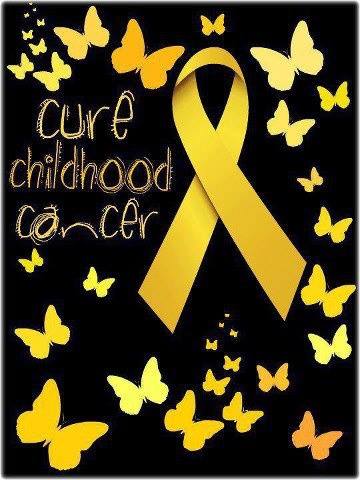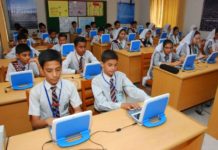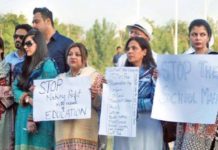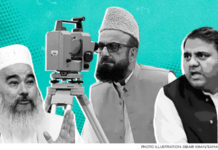CHILDHOOD CANCER
Asma was worried about Ali, as usual today he has gotten up with headache and is feeling nausea.Asma and Asif are witnessing this worsening condition of Ali from last 5 days now. She asked Asif to take an appointment from the doctor. Asif was upset too because he is watching Ali loosing weight frequently. When Asif went to work, he was thinking about how Ali always insisted him to play football games with him but now Ali has changed and is always lethargic and down. These thoughts made Asif more depressed and uncomfortable, as Ali is his only child.. He took an appointment from one of the best doctor. When they visited the doctor that day, the doctor found a lump near Ali’s neck, he examined that and suggested some blood tests and biopsy..Ali’s condition got bad to worse, soon after the results have come, they rushed the doctor and asked him about the causes of such illness. The doctor was an expert he said that he is sorry to declare that Ali is having cancer. He said that when they visited him the last time , he found a lump,, but he wasn’t sure of its cause so he didn’t discussed it earlier. Asma and Asif were feeling as if they both have lost their life. They were in shock and in a state of disbelief. It seems as there life has halted. The doctor told him not to worry and if Ali’s treatment will start, he will be alright and the case is not that serious. It was the most difficult time for both of them watching their child in pain and he should have to bear more pain to survive.
This is just a case of childhood cancer diagnosis but it’s a fact that childhood cancer is very difficult to be detected.
A cancer diagnosis is upsetting at any age, but especially so when the patient is a child. It’s natural to have many questions, such as, Who should treat my child? Will my child get well? What does all of this mean for our family.
CHILDHOOD CANCER
The first and the foremost thing to begin with is, how cancer appears in children, the answer to this question is ,some children inherit DNA changes (mutations) from a parent that increase their risk of certain types of cancer but most childhood cancers are not caused by inherited DNA changes however they are the result of DNA changes that happen early in the child’s life, sometimes even before birth.
Cancer in children can occur anywhere in the body, including the blood and lymph node system, brain and spinal cord (central nervous system; CNS), kidneys, and other organs and tissues.
Cancer begins when healthy cells change and grow out of control. These cells form a mass called a tumour, which can be cancerous or benign. A cancerous tumour is malignant, meaning it can grow and spread to other parts of the body. A benign tumour means the tumour can grow but will not spread to distant parts of the body.
In leukaemia, a cancer of the blood that starts in the bone marrow, these abnormal cells rarely form a solid tumour. Instead these cells crowd out other types of cells in the bone marrow. This prevents the production of:
.Normal red blood cells. Cells that carry oxygen to tissues.
.White blood cells. Cells that fight infection.
.Platelets. The part of the blood needed for clotting.
Most of the time, there is no known cause for childhood cancers. Cancer diagnosis evokes much fear and anxiety in parents and caregivers, but early diagnosis and treatment can result in improved patient outcomes.
STATISTICS OF CANCER IN CHILDREN
According to the current statistics, more than 300,000 children are diagnosed with cancer globally every year and it is one of the leading cause of morbidity and mortality among children and adolescents.
In Pakistan, annually, approximately 8,000 children, under the age of 18 years are diagnosed with cancer.
Pakistan has a vulnerable position in terms of cancer treatment. Approximately 50 percent children have no access to treatment and 70 percent do not complete treatment.
COMMON TYPES OF CHILDHOOD CANCER
The most common malignancies in children from birth to age 14 years are:
.Acute lymphoblastic leukaemia
It is the most common type of cancer in children, it is cancer of the blood and bone marrow. Normally the bone marrow makes stem cells that mature into blood cells over time. In ALL, too many stem cells turn into immature white blood cells (lymphoblasts) that don’t mature into the normal blood cells (lymphocytes) that fight infection by attacking germs and other harmful bacteria.
.Bone Cancers (Osteosarcoma)
.Brain Cancers (and Brain Stem Tumors)
.Leukaemia
.Hepatoblastoma (Liver Cancer)
.Lymphoma (Hodgkin’s and Non-Hodgkin’s)
.Neuroblastoma
.Rhabdomyosarcoma
.Retinoblastoma
.Rhabdoid Tumours
.Sarcoma
.Spinal Cord Tumours
.Wilms Tumour (Kidney Tumors)
DIAGNOSIS OF CHILDHOOD CANCER
The early signs and symptoms of childhood cancers may often mimic common childhood illnesses, which may consequently delay diagnosis and treatment.
The diagnostic interval (DI) is the time between presentation of signs and symptoms and the diagnosis of cancer.
Parents are often the first to notice that something isn’t right with their children and they bring them to the doctor. An appropriate diagnostic evaluation is important when childhood cancer is suspected.
Childhood cancer is diagnosed in all ages, from newborn infants to children and young adults.
The doctor will ask about medical history and symptoms, and examine your child. If cancer is a possible cause, the doctor might order imaging tests (such as x-rays) or other tests. Sometimes if an abnormal lump or tumour is found, the doctor might need to remove some or all of it so that it can be looked at under a microscope for cancer cells. This is known as a biopsy.
Despite the fact that mortality has declined, childhood cancer continues to be a devastating diagnosis. The families of children with cancer are affected not only by the disease and treatments, but also by significant effects on the child’s physical and emotional development.
SIGNS AND SYMPTOMS OF CHILDHOOD CANCER
.Continued, unexplained weight loss
.Headaches, often with early-morning vomiting
.Increased swelling or persistent pain in bones, joints, back, or legs
.Lump or mass, especially in the abdomen, neck, chest, pelvis, or armpits
.Development of excessive bruising, bleeding, or rash
.Constant infections
.A whitish colour behind the pupil
.Nausea that persists or vomiting without nausea
.Constant tiredness or noticeable paleness
.Eye or vision changes that occur suddenly and persist
.Recurrent or persistent fevers of unknown origin.
TYPES OF TREATMENT
There are many types of cancer treatment. The types of treatment depends on the type of cancer and how advanced it is. Common treatments include: surgery, chemotherapy, radiation therapy, immunotherapy, and stem cell transplant, targeted therapy. Targeted therapy uses substances that attack cancer cells without harming normal cells.
Childhood cancers are rare, and only specially-trained doctors have the knowledge and experience to properly treat them.
BAD EFFECTS OF TREATMENT
Children face unique issues during their treatment for cancer, after the completion of treatment, and as survivors of cancer. It’s essential for childhood cancer survivors to receive follow-up care to monitor their health after completing treatment.
Survivors of any kind of cancer can develop health problems months or years after cancer treatment, known as late effects.Late effects vary with the type of cancer, the child’s age, the type of treatment, and other factors.
Long-term effects of childhood cancer and treatment include problems in these areas:
.growth and development
.cognition
.vision
.hearing
.behaviour
.cardiovascular system
.musculoskeletal system
.pulmonary system
.teeth
.reproductive system
Adjusting to a child’s cancer diagnosis and finding ways to stay strong is challenging for everyone in a family.
There is a lot of research going on to discover new treatments for childhood cancer. This research has greatly improved the overall survival rate for children with cancer, which is now more than 80%.








